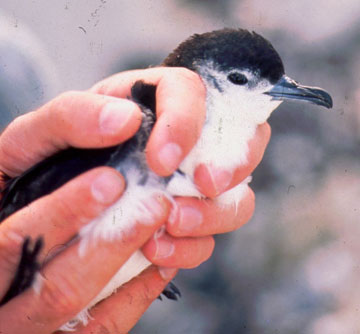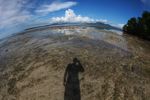Researchers have uncovered a new seabird native to Hawaii stuffed in a museum. Originally identified as a smaller variation of a little shearwater (Puffinus assimilis), DNA tests showed that the bird, which was collected over four decades ago, was in fact a unique species. Named Bryan’s shearwater (Puffinus bryani), the fate of this bird in the wild remains unknown.
“It’s very unusual to discover a new species of bird these days and especially gratifying when DNA can confirm our original hypothesis that the animal is unique. This bird is unique, both genetically and in appearance, and represents a novel, albeit very rare, species,” explains Rob Fleischer, head of Smithsonian Conservation Biology Institute’s Center (SCBI) for Conservation and Evolutionary Genetics where the DNA was analyzed, in a press release.
Bryan’s shearwater is now the smallest of the world’s 22 shearwater species. The museum specimen was collected 1963 in a burrow among petrels during the Pacific Ocean Biological Survey Program. Genetic evidence now shows that Bryan’s shearwater separated from its closest relative, Boyd’s shearwater (Puffinus boydi), two million years ago.
 Bryan’s shearwater. Photo by: Reginald David. |
The problem is no one knows where to find the new species in the wild. According to researchers, its breeding ground could be anywhere in the Pacific.
“We don’t believe that Bryan’s shearwaters breed regularly on Midway or other Northwestern Hawaiian Islands, based on the extensive seabird work in these islands during the Pacific Seabird Project,” Peter Pyle, an ornithologist at the Institute for Bird Populations, who first noticed the specimen was possible a new species.
While researchers are hopeful the bird is still soaring, there is a chance it is extinct. Most likely it is rare, and probably endangered, given that it has avoided identification until now.
“If we can find where this species breeds, we may have a chance to protect it and keep it from going extinct,” Andreanna Welch, a Smithsonian predoctoral fellow at SCBI who worked on the seabird’s DNA. “Genetic analysis allows us to investigate whether an animal represents an entirely different species, and that knowledge is important for setting conservation priorities and preventing extinction.”
No new seabird has been identified for over half a century until this year when, bizarrely enough, two new seabirds have been announced thus far. Earlier in the year, researchers announced the discovery of another new seabird, this one a storm petrel, off the coast of Chile. They are currently working on analyzing the bird, but are confident it has never been described before.
Related articles
New seabird discovered, first in 55 years
(03/23/2011) Stephen Maturin, if he were not fictional, would be delighted. A new seabird has been discovered by an international expedition headed by one of the world’s top seabird-experts, Peter Harrison, after he received photos from vacationing birders of an unusual looking storm petrel off the coast of Chile.
Longline fishing still drowning over a quarter million seabirds every year
(06/08/2011) A new analysis estimates that longline fisheries are still decimating seabirds, even after years of efforts to mitigate deaths. According to a study in Endangered Species Research around 300,000 seabirds are drowned by longline fisheries as bycatch. Attracted by bait on the longline—sometimes measuring hundreds of miles as it trails on the surface behind a boat—birds are often hooked and drowned.
Ocean prognosis: mass extinction

(06/20/2011) Multiple and converging human impacts on the world’s oceans are putting marine species at risk of a mass extinction not seen for millions of years, according to a panel of oceanic experts. The bleak assessment finds that the world’s oceans are in a significantly worse state than has been widely recognized, although past reports of this nature have hardly been uplifting. The panel, organized by the International Program on the State of the Ocean (IPSO), found that overfishing, pollution, and climate change are synergistically pummeling oceanic ecosystems in ways not seen during human history. Still, the scientists believe that there is time to turn things around if society recognizes the need to change.